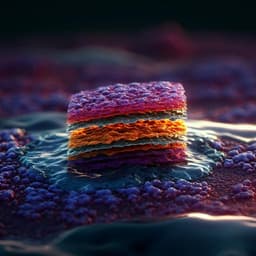
Physics
Two-dimensional higher-order topology in monolayer graphdiyne
E. Lee, R. Kim, et al.
This research by Eunwoo Lee, Rokyeon Kim, Junyeong Ahn, and Bohm-Jung Yang introduces monolayer graphdiyne as an exciting candidate for a two-dimensional higher-order topological insulator. The study reveals intriguing phenomena like charge accumulation at corners and nontrivial bulk topology, emphasizing the pivotal role of core level contributions in understanding its remarkable properties.
~3 min • Beginner • English
Introduction
The study addresses higher-order topological insulators (HOTIs), in which gapless boundary modes appear on subspaces of dimension lower than conventional (d−1)-dimensional boundaries, such as corners or hinges. While several 3D HOTI materials have been proposed and observed, realizing 2D second-order topological insulators (SOTIs) with robust corner states is challenging because chiral or particle–hole symmetry is typically absent in real materials. Even without chiral symmetry, 2D systems can exhibit higher-order topology as obstructed atomic insulators (2D dth-order), whose hallmark is a filling anomaly and quantized fractional corner charge protected by crystalline symmetries. The authors propose monolayer graphdiyne (MGD) as a realistic 2D HOTI protected by inversion symmetry. They identify a Z2 invariant w2 diagnosing the higher-order topology: MGD has w2=1 while its 1D polarization invariants w1x and w1y vanish. Although low-energy bands can be modeled with pz orbitals, capturing the nontrivial topology requires inclusion of core s, px, py states. They further connect the 2D topology to ABC-stacked 3D graphdiyne, predicting monopole nodal lines and hinge states.
Literature Review
The paper situates 2D HOTIs within broader HOTI research: 3D examples include rhombohedral bismuth (helical hinge modes), strained SnTe, MoTe2 and WTe2 (helical hinge states), and magnetic axion systems with chiral hinges. In 2D, prior theoretical proposals include phosphorene (corner states from 1D polarization, not a genuine 2D HOTI) and twisted bilayer graphene (requiring fine control of twist angle and chemical potential). Theory indicates that dth-order TIs in d dimensions are obstructed atomic insulators without stable Wannier obstruction; corner states generally require chiral or particle–hole symmetry, often absent. However, higher-order topology can manifest via filling anomalies protected by crystalline symmetries (inversion, mirrors), leading to fractional corner charges even when corner in-gap states hybridize with bulk. Symmetry-indicator approaches and Wilson loop/nested Wilson loop methods provide diagnosis of w2 from parity data at TRIMs. Prior work on ABC-stacked graphdiyne predicted Z2-monopole nodal lines, consistent with layering of 2D slices with nontrivial w2.
Methodology
- First-principles DFT: Vienna Ab initio Simulation Package (VASP) with PAW potentials and GGA-PBE exchange-correlation. Plane-wave cutoff 500 eV; k-point mesh 12×12×1 for monolayer; Γ point for finite flakes. Optimized monolayer structure: in-plane lattice parameter a=9.46 Å; bond lengths b1=1.43 Å, b2=1.40 Å, b3=1.23 Å, b4=1.34 Å. SOC neglected (spinless approximation) due to weak SOC in carbon.
- Tight-binding models: pz-only basis for low-energy description. Intralayer nearest-neighbor hopping with distance-dependent transfer Vppπ = V0 exp(−(R−d0)/r0), V0 = −2.7 eV, d0=0.142 nm, r0=0.09 nm. Interlayer couplings for ABC stacking via two shortest vertical bonds with Vppσ = 0.48 eV at d0=0.335 nm, same exponential form. Finite-size geometries constructed to preserve inversion and a mirror My line; hydrogen passivation used selectively along edges.
- Symmetry and topological analysis: Computed parity eigenvalues at TRIMs from DFT to evaluate Z2 indicators w1x, w1y via 1D Berry phase/polarization, and w2 via parity counting formula. Wilson loop spectra computed along reciprocal directions to extract Wannier centers and polarization; nested Wilson loops evaluated within the Wilson band subspace centered at v=π; determinant of nested Wilson loop used to confirm nontrivial w2. Projection of Wilson/nested Wilson loop to orbital subspaces (pz vs s+px+py) to identify orbital origin of topology.
- k·p edge theory: Low-energy 4×4 Dirac-like Hamiltonian near Γ with symmetry representations (time-reversal, inversion, mirrors) used to derive edge theory on a circular boundary, identify symmetry-allowed mass terms, and locate mass domain walls at My-invariant corners supporting localized corner states.
- Finite-size electron counting: For n×n supercells, counted total states N and number of non-bonding edge states; tracked changes upon breaking chiral symmetry and upon hydrogen passivation to demonstrate filling anomaly and corner charge accumulation.
Key Findings
- Topological invariants: Monolayer graphdiyne (MGD) has w1x = w1y = 0 and w2 = 1 from DFT parity eigenvalues, indicating a 2D higher-order topological insulator protected by inversion symmetry.
- Orbital origin: Considering only pz-derived bands yields w2 = 0 (topologically trivial), whereas including core s, px, py orbitals restores w2 = 1. Thus, higher-order topology originates from core-level bonding, not from the isolated low-energy pz sector.
- Wilson loop diagnostics: Wilson loop spectra show zero net polarization in both reciprocal directions and a single linear crossing at (k1=0, v=π), consistent with w2 = 1. Nested Wilson loop determinant is nontrivial (−1), further confirming w2 = 1. Projected analyses give w2 = 0 for pz-only and w2 = 1 for s+px+py sectors.
- Filling anomaly and corner charges: For finite, inversion- and My-symmetric flakes, two corner-related in-gap states exist with chiral symmetry; when chiral symmetry is broken (as in realistic systems), these merge with bulk bands, yielding an odd number of holes/electrons below/above the gap at half-filling (filling anomaly). Resolving the anomaly by adding one electron (or hole) leads to ±1/2 e charge at the two My-invariant corners. Example counting: total states N = 72 n^2 for n×n cells; upon symmetry-allowed hybridizations, ngap = 36 n^2 + 4 n − 1 (odd offset), demonstrating w2 = 1.
- Edge passivation control: Adding hydrogen to all corners except the two My-invariant ones preserves w2 and isolates two non-bonding corner states; adding two extra hydrogens at My-invariant corners changes N→N+2 and toggles w2 to 0. Maintaining hydrogen additions in multiples of four preserves w2.
- Wannier-center picture: Indices vA = vB = vC = vD = 1 at inversion-symmetric Wyckoff positions imply Wannier centers displaced from atoms due to s–p bonding across unit-cell boundaries. Derived relation w2 = vB vC + vC vD + vD vB (mod 2) links bonding pattern to w2 = 1.
- 3D extension: ABC-stacked graphdiyne exhibits kz-resolved slices with w2 = 1 for |kz| < kc and w2 = 0 for kc < |kz| < π, yielding hinge modes in the nontrivial kz window and Z2-monopole nodal lines created at band inversion. TB with pz reproduces hinge modes’ kz window qualitatively but reverses the w2 assignment unless core orbitals are included; including them restores consistency with DFT.
Discussion
The findings demonstrate that monolayer graphdiyne is a 2D higher-order topological phase protected by inversion symmetry, detectable via filling anomaly and fractional corner charges even in the absence of exact chiral symmetry. The necessity of including core s, px, py orbitals shows that higher-order topology can be driven by chemical bonding across unit-cell boundaries, reflected in Wannier centers at inversion-symmetric Wyckoff positions rather than at atomic sites. The parity, Wilson loop, and nested Wilson loop diagnostics consistently identify w2 = 1. The corner-charge phenomenology is robust to edge details provided inversion and the relevant mirror line are preserved; hydrogen passivation manipulates boundary states without altering the bulk invariant when applied in symmetry-compatible multiples. Stacking MGD layers extends the 2D higher-order topology to 3D, resulting in weak Stiefel-Whitney insulating phases and, with stronger interlayer coupling, nodal-line semimetal phases with Z2 monopole charge and kz-selective hinge states. This connects 2D higher-order invariants to 3D hinge transport and spectroscopic signatures.
Conclusion
The study proposes monolayer graphdiyne as a realistic two-dimensional higher-order topological insulator protected by inversion symmetry, characterized by w2 = 1 and vanishing polarizations w1x,y. While a pz-only model captures low-energy dispersions, it misses the nontrivial topology; inclusion of core s, px, py orbitals is essential. The higher-order topology manifests via filling anomaly and ±1/2 corner charges at mirror-invariant corners under inversion-preserving terminations, supported by parity analysis, Wilson and nested Wilson loops, finite-size state counting, and a k·p boundary theory. Extending to ABC-stacked graphdiyne, the work predicts kz-selective hinge modes and monopole nodal lines consistent with a change in w2 across kz. The methodology provides a general route to identify and diagnose HOTIs lacking chiral symmetry in real materials and can be generalized to other dth-order topological phases with corner charges.
Limitations
- The demonstration is theoretical; no experimental observation of corner charges or hinge states is provided. Detection would require symmetry-preserving terminations and control over boundary chemistry.
- Spin–orbit coupling is neglected; while small in carbon, any residual SOC or interactions could shift or broaden boundary features.
- The pz-only tight-binding model misclassifies w2, requiring inclusion of core orbitals for correct topology; constructing accurate multi-orbital tight-binding models may be complex.
- Corner-state energies depend on chiral-symmetry-breaking terms and may hybridize with bulk bands; observing isolated in-gap corner modes is not guaranteed without fine edge control.
- Hinge-mode analysis for ABC stacking uses simplified pz models for tractability; quantitative kz windows and dispersions may differ when full orbital sets and realistic couplings are included.
Related Publications
Explore these studies to deepen your understanding of the subject.







